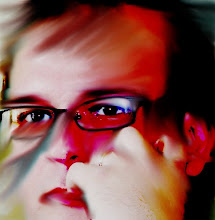 |
| "My Dog Tulip" Photo Courtesy: New Yorker Films |
“My Dog Tulip” is a milestone in animation. It is the first paperless, hand-drawn animated feature ever.
Of course that wouldn’t count for much if the movie wasn’t very good, but I’ll get to the analysis of the film’s content itself shortly.
Paul Fierlinger drew the film onto a digital tablet, using a stylus and Sandra Fierlinger filled in the images perfectly. She seems to know just the right colors to capture the right moods and just how much detail to use without giving too much away. They used a program called “TVPaint.”
 |
| Photo Courtesy: New Yorker Films |
“Tulip” is based on J. R. Ackerley’s memoirs of how he finally found true friendship late in his life when he got his first dog, Tulip. Ackerley is voiced by Christopher Plummer.
I have not read the book in more than 10 years, but I remember laughing out loud a lot and as I watched the film, I kept remembering bits of the book I’d forgotten.
The film, like the book, is pretentious, funny and literate. So naturally, your Resident Film Snob loved it to pieces.
Ackerley whittles the most complex human emotions and experiences down into the basest of animal urges and what he comes out with in his book, is a remarkably wise record, not only of anecdotes, but proverbs.
For example, in the midst of his meditations on Tulip’s bathroom habits, Ackerley takes her through a cemetery. He seems to think the dead should be grateful that his dog is blessing them by using their resting place as a place to unleash her bowels.
After all, they ought to be grateful to be serving any purpose at all, shouldn’t they?
 | |
| Tulip diddles on the dead. Photo Courtesy: New Yorker Films |
The film’s style could not possibly fit the spirit of the book better. Paul and Sandra Fierlinger don’t draw “Tulip” with the realistic detail the Pixar generation has come to expect. After all, if it’s going to look so gall-darn realistic, why bother animating it? (That’s right, I said “gall-darn.” You’ll just have to pardon my French.)
Animation style dips several times into what the author sketched as he imagined his dog and sister home alone together. These sequences are simple doodles on paper.
Notice how, for some reason, as minimalist as his “style” is, he still takes the time to draw boobs on his sister. It’s either endearing or creepy. I guess it can be both. Hey, the guy wrote “The Prisoners of War,” so I’m not going to get all bent out of shape.
 |
| Photo Courtesy: New Yorker Films |
And what he projects of human sexuality onto dogs is hysterical and emphasized through this simple doodling that he does, more than it ever could through more sophisticated animated effects.
This is important, since roughly half the movie involves Ackerley trying to get his beloved dog laid.
 |
| Photo Courtesy: New Yorker Films |
Again, he goes about exploring sexuality by simplifying it through the eyes of his dog and again, the stripped down animated style is perfect here. It’s equally adorable and disconcerting how Tulip is drawn in a dress, like a lady of the night.
 |
| Photo Courtesy: New Yorker Films |
It’s touching how he marvels at the way Tulip allows a very small dog to hump her even though Ackerley clearly thinks Tulip is far out of the mutt’s league.
If you miss it, put it in your Netflix queue pronto.



No comments:
Post a Comment